
 |
||||||||||||||
|
|
|
|
|
|
|
|
|
|
|
|
|
|
|
|
|
|
|
|
|
|
|
|
||||||||
 |
|
|||||||||||||||
 |
 |
|
|
|||||||||||||
|
|
 |
 |
|
|||||||||||||
 |
|
|||||||||||||||
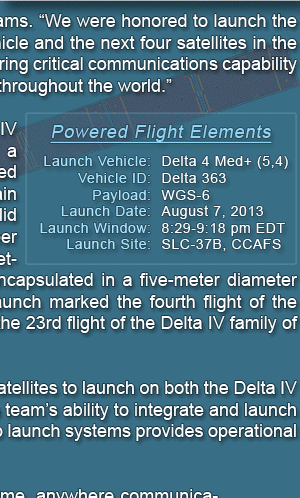 |
|
|||||||||||||||
|
|
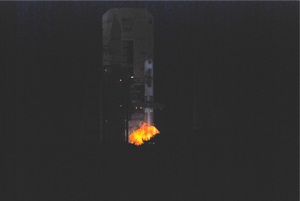 |
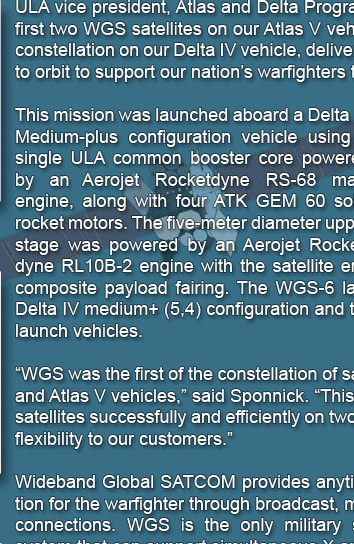 |
|
|||||||||||||
 |
|
|||||||||||||||
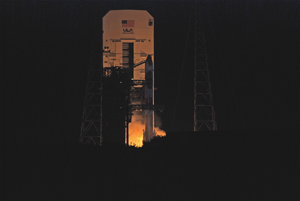 |
|
|||||||||||||||
 |
|
|||||||||||||||
 |
 |
|
||||||||||||||
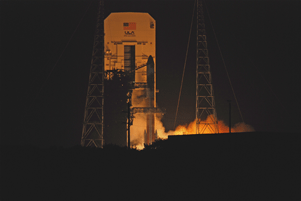 |
 |
|
||||||||||||||
 |
|
|||||||||||||||
|
|
 |
|
||||||||||||||
 |
|
|||||||||||||||
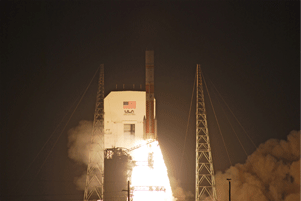 |
 |
|
||||||||||||||
 |
|
|||||||||||||||
|
|
 |
|
||||||||||||||
 |
|
|||||||||||||||
 |
|
|||||||||||||||
 |
|
|||||||||||||||
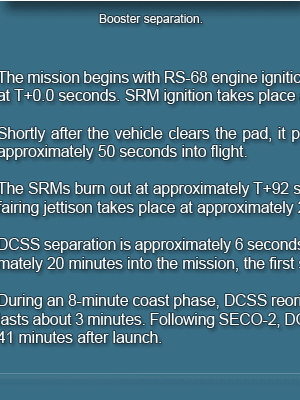 |
|
|||||||||||||||
 |
 |
|
|
|||||||||||||
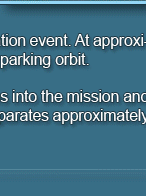 |
|
|||||||||||||||
|
|
|
|
|
|||||||||||||
|
|
|
|||||||||||||||
|
|
|
|
|
|
|
|
|
|
|
|
|
|
|
|
|
|

|
WGS-6 Wideband Global SATCOM United Launch Alliance Successfully Launches Second Wideband Global SATCOM Mission for U.S. Air Force in Less Than Three Months Cape Canaveral Air Force Station, Fla., (Aug. 7, 2013) � A United Launch Alliance (ULA) Delta IV rocket successfully launched the sixth Wideband Global SATCOM (WGS-6) satellite for the U.S. Air Force at 8:29 p.m. EDT today from Space Launch Complex-37. This is ULA�s seventh launch in 2013, the 73rd launch since the company was formed in December 2006, and the second WGS mission launch this year. "Congratulations to the entire team on today�s successful launch of the WGS-6 satellite. As with the previous five WGS missions, we have enjoyed a very strong partnership with the Air Force and all of our missions partners throughout this launch campaign,� said Jim Sponnick, ULA vice president, Atlas and Delta Programs. �We were honored to launch the first two WGS satellites on our Atlas V vehicle and the next four satellites in the constellation on our Delta IV vehicle, delivering critical communications capability to orbit to support our nation�s warfighters throughout the world.� This mission was launched aboard a Delta IV Medium-plus configuration vehicle using a single ULA common booster core powered by an Aerojet Rocketdyne RS-68 main engine, along with four ATK GEM 60 solid rocket motors. The five-meter diameter upper stage was powered by an Aerojet Rocketdyne RL10B-2 engine with the satellite encapsulated in a five-meter diameter composite payload fairing. The WGS-6 launch marked the fourth flight of the Delta IV medium+ (5,4) configuration and the 23rd flight of the Delta IV family of launch vehicles. �WGS was the first of the constellation of satellites to launch on both the Delta IV and Atlas V vehicles,� said Sponnick. �This team�s ability to integrate and launch satellites successfully and efficiently on two launch systems provides operational flexibility to our customers.� Wideband Global SATCOM provides anytime, anywhere communication for the warfighter through broadcast, multicast, and point to point connections. WGS is the only military satellite communications system that can support simultaneous X and Ka band communications. WGS-6 SATELLITE | Overview WGS supports communications links in the 500 MHz range of the X-band and 1 GHz range of the Ka-band spectra. WGS can filter and route up to 4.875 GHz of instantaneous bandwidth. WGS-6, the third Block II satellite, includes a high-bandwidth radio frequency (RF) bypass capability in addition to the previous capabilities provided by the Block I satellites. Depending on the mix of ground terminals, data rates, and modulation schemes employed, a WGS satellite can support data transmission rates between 2.4 and 3.6 Gbps. WGS has 19 independent coverage areas that can be positioned throughout its field of view. This includes eight steerable/shapeable X-band beams formed by separate transmit/receive phased arrays; 10 Ka-band beams served by independently steerable diplexed antennas (three with selectable RF polarization); and transmit/receive X-band Earth-coverage beams. WGS can tailor coverage areas and connect X-band and Ka-band users anywhere within its field of view. Four Army Wideband Satellite Operations Centers (WSOC) provide command and control of WGS. Each Global SATCOM Configuration and Control Element (GSCCE) has the capability to control up to three satellites at a time, using X-band or Ka-band telemetry and command links. Spacecraft platform control is accomplished by the 3rd Space Operations Squadron at Schriever Air Force Base in Colorado Springs, CO, using WGS mission-unique software and databases. Support technologies for WGS include the xenon-ion propulsion system (XlPS), which is 10 times more efficient than conventional bipropellant systems, highly efficient triple-junction gallium arsenide solar cells, and deployable radiators with flexible heat pipes. Four 25-cm XlPS thrusters remove orbit eccentricity during transfer orbit operations. The thrusters are also used to perform orbit maintenance and any required station-change maneuvers during the mission�s life. The triple-junction gallium arsenide solar cells provide on-orbit electrical power for the spacecraft. The deployable radiators� flexible heat pipes provide increased radiator area, resulting in a cooler, more stable thermal environment for the satellite. DELTA IV MEDIUM+ (5,4) launch vehicle | Overview The Delta IV Medium+ (5,4) consists of a single Delta IV common booster core (CBC), the Delta cryogenic second stage (DCSS), four solid rocket motors (SRM) and a 5-m diameter payload fairing. The CBC and the DCSS are connected by a composite cylindrical interstage adapter (ISA). The SRMs are connected to the booster by two ball-and-socket joints and four structural thrusters. The SRMs are approximately 5 ft in diameter and 53 ft long, and are constructed of a graphite/epoxy composite. Their throttle profile is designed into their propellant grain. Two of the SRMs have thrust vector control (TVC) capabilities, and two have fixed nozzles. The SRMs burn for approximately 92 seconds and are jettisoned at roughly 100 seconds into the flight. The Delta IV booster tanks are structurally rigid, and constructed of isogrid aluminum barrels, spun-formed aluminum domes, machined aluminum tank skirts, and a composite centerbody. Delta IV booster propulsion is provided by the RS-68 engine system. The RS-68 burns cryogenic liquid hydrogen and liquid oxygen, and delivers 663,000 lb of thrust at sea level. The booster�s cryogenic tanks are insulated with a combination of spray-on and bond-on insulation, and helium-purged insulation blankets. The Delta IV booster is controlled by the DCSS avionics system, which provides guidance, flight control, and vehicle sequencing functions during CBC and DCSS phases of flight. The boost phase of flight ends 6 seconds after main engine cutoff (MECO), when the separation charge in the interstage adapter is fired and 16 pneumatic actuators push the spent Delta IV CBC stage and the DCSS apart. The DCSS propellant tanks are structurally rigid and constructed of isogrid aluminum ring forgings, spun-formed aluminum domes, machined aluminum tank skirts and a composite intertank truss. The DCSS is also a cryogenic liquid hydrogen/liquid oxygen-fueled vehicle. It uses a single RL10B-2 engine that produces 24,750 lb of thrust. Like the CBC, the DCSS cryogenic tanks are insulated with a combination of spray-on and bond-on insulation, and helium-purged insulation blankets. An equipment shelf attached to the aft dome of the DCSS liquid oxygen tank provides the structural mountings for vehicle electronics. The structural and electronic interfaces with the spacecraft (SC) are provided by the payload attach fitting (PAF). The WGS-6 mission uses a 5-m diameter payload fairing (PLF). The PLF is a composite bisector (two-piece shell) fairing. The vehicle�s height, with the 47-ft tall PLF, is approximately 217 ft. Delta IV WGS-6 | Mission Overview The WGS-6 mission will be flown on an easterly trajectory from Space Launch Complex 37 at Cape Canaveral Air Force Station (CCAFS), FL. The Delta IV will release the WGS-6 satellite into a supersynchronous transfer orbit. The mission begins with RS-68 engine ignition approximately 5.5 seconds prior to liftoff (T-5.5 seconds). Liftoff occurs at T+0.0 seconds. SRM ignition takes place at T-0.02 seconds after telemetry indication of healthy RS-68 startup. Shortly after the vehicle clears the pad, it performs its pitch/yaw/roll program. Maximum dynamic pressure occurs approximately 50 seconds into flight. The SRMs burn out at approximately T+92 seconds, and are jettisoned in pairs at T+100 and 102 seconds. Payload fairing jettison takes place at approximately 207 seconds; about 40 seconds prior to main engine cutoff (MECO). DCSS separation is approximately 6 seconds after MECO. DCSS main engine start occurs 13 seconds after the separation event. At approximately 20 minutes into the mission, the first second stage engine cutoff (SECO-1) occurs and DCSS has achieved its parking orbit. During an 8-minute coast phase, DCSS reorients itself for restart. Restart ignition takes place approximately 28 minutes into the mission and lasts about 3 minutes. Following SECO-2, DCSS re-orients its attitude for the separation event. The WGS-6 satellite separates approximately 41 minutes after launch. |